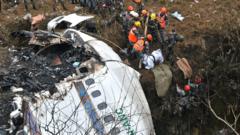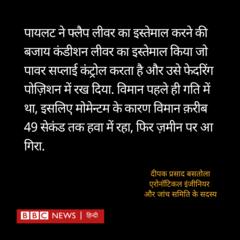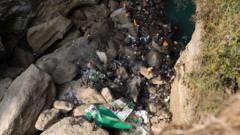
image source, PRAKASH MATTHEMA/AFP via Getty Images
According to a report by government-appointed investigators, the plane crash in Nepal in January this year was probably caused by the pilot's mistake in cutting off the plane's power supply.
A total of 72 people lost their lives in this plane accident, including two children.
According to the report, due to power supply cut, the plane stopped getting thrust and reached a state of “stopping at one place in the air”.
This Yeti Airlines plane going from Nepal's capital Kathmandu to Pokhara had fallen near Pokhara. This accident happened on January 15.
This accident was described as the most painful accident of the last 30 years.
What does the report say?
The aircraft that was the victim of the accident was ATR 72. This was the third flight of that aircraft on 15 January. Before this, the plane had traveled from Kathmandu to Pokhara twice.
This private plane had fallen into a ditch near the Seti river, just one and a half kilometers away from Pokhara airport. Relief work was started immediately after the accident, in which more than a hundred Nepali Army soldiers were deployed.
Aeronautical engineer Deepak Prasad Bastola, a member of the investigating committee, told news agency Reuters, “The plane was already in motion, so due to the momentum, the plane remained in the air for about 49 seconds, and then fell on the ground.”
He explained that it is possible that instead of using the flap lever, the pilot used the condition lever, which controls the power supply, and placed it in the feathering position.
He says, “This caused the engine to stop suddenly and the required thrust was not provided to fly the plane.”

According to the report, “The crew did not identify the problem after both engine propellers inadvertently came into feathering position and did not correct the problem despite warning from the crew alerting panel.”
Other reasons for the accident, the report says, include the crew not receiving proper training in terms of technology and skills, work pressure and stress on them, and not following standard operating protocols.
It has also been said in the report that the maintenance of the aircraft was proper and there were no deficiencies. The crew members sitting in the cockpit were qualified under the policy rules of Nepal Civil Aviation Authority.
About a dozen experts from America, Canada, France and Singapore were involved in the investigation of the accident.

image source, Prabin Ranabhat/SOPA Images/LightRocket via Getty Images
Local resident Divya Dhakal told the BBC in January that she saw the plane go down at 11 am (5:15 am according to Greenwich Mean Time), after which she ran towards Hasde's place.
She said, “By the time I reached there, many other people had also reached there. The plane was on fire, smoke was coming out of it. After some time, helicopters arrived there.”
The European Union has banned Nepalese airlines from flying through its airspace for the past decade, citing security reasons.
Plane accidents are not a new thing in Nepal. Due to remote runways at difficult places and suddenly changing weather, plane accidents have happened here before.
In May last year, Tara Air Flight No. 197 of Yeti Airlines crashed into the mountains. The crew and 22 passengers were killed in the accident.





